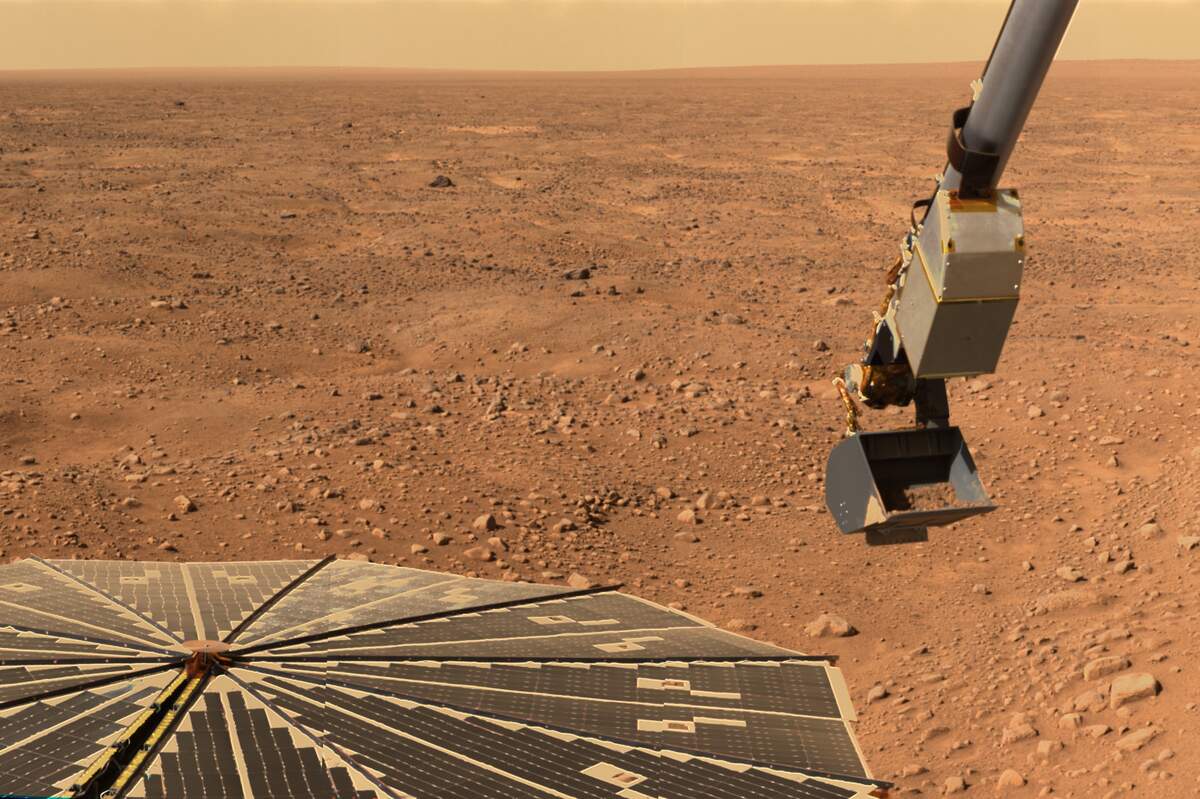

Red Planet Day
Red Planet Day commemorates the launch of the Mariner 4 spacecraft and is a day to celebrate the planet Mars and learn more about it. Mariner 4, a robotic interplanetary probe, was launched by NASA and the Jet Propulsion Laboratory (JPL) on November 28, 1964. It was the fourth of a series of spacecraft designed to fly past planets, and it became the first to fly past Mars. It provided the first close-up photos of the planet, and the first from-space images of another planet ever. Besides taking photos, the spacecraft's objectives were to take field and particle measurements in interplanetary space near the planet and to provide researchers with information about long interplanetary flights.
Mariner 4 had an octagonal magnesium frame, 45.7 centimeters in height and 127 centimeters across. Equipped with antennas and other instruments, the spacecraft's overall height was 289 centimeters, and from end to end was 688 centimeters. It was powered by four solar panels that were at its top, and it could also draw from a rechargeable battery. Hydrazine, a monopropellant, was used for propulsion, fueling a motor installed on one of the spacecraft's sides. A television camera was mounted at Mariner 4's bottom center, and the spacecraft was equipped with scientific instruments such as a magnetometer, solar plasma probe, cosmic ray telescope, dust detector, trapped radiation detector, and ionization chamber/Geiger counter.
When it launched, the spacecraft jettisoned a protective shroud covering, and then separated from an Atlas D booster. Mariner 4 was still joined to an Agena D rocket at the time. The rocket's first burn put the spacecraft into Earth parking orbit, and its second burn put it into Mars' transfer orbit. It then separated from the Agena D and entered cruise mode. The solar panels were soon deployed, taking in the sun.
On July 14, 1965, after 228 days, Mariner 4 flew past Mars. At 00:18:36 Universal Time (UT) on July 15 (7:18:49 pm Eastern Standard Time [EST] July 14), it began taking pictures of the planet, capturing 21 pictures as well as 21 lines of a 22nd picture. The images were transferred to Earth twice. They showed a crater-filled, moon-like area, which later was found to be non-traditional compared to other parts of the planet. The spacecraft reached its closest point to Mars at 01:00:57 UT on July 15 (8:00:57 p.m. EST July 14), at 6,118 miles from the planet. During the next few years, Mariner 4 continued to transfer data to Earth. Communications with the spacecraft were terminated on December 21, 1967. The total data returned from the mission was 5.2 million bits, and all experiments were successful except the ionization chamber/Geiger counter and the plasma probe. The total cost of the mission was estimated to be about $83.2 million.
Mars is known as the "Red Planet" because it appears to be red on account of the iron-rich minerals on its surface that have rusted into iron oxide. Mars' name comes from Ares, the Greek god of war. The corresponding Roman god is Mars. It is the seventh-largest planet in the solar system, with about one-tenth the mass of Earth, which is the fifth-largest planet. But, it has a similar amount of landmass as Earth, as Earth is about 70% water.
Mars can often be seen from Earth with the naked eye. It is the fourth planet from the Sun, averaging a distance of 136,764,000 miles from it, and it takes Mars 687 days to orbit around it, meaning the planet's seasons are almost twice as long as Earth's. It makes its orbit in an oval-shaped pattern, which causes its weather to be more extreme than Earth's. Still, the tilt of its axis is about 25 degrees, which is similar to the tilt of the Earth, so its seasons are similar to Earth's. When closest to the Sun, the planet's Southern Hemisphere is tilted towards it. It experiences a short, hot summer, while the Northern Hemisphere has a short, cold winter. When the planet is farthest from the sun, the Northern Hemisphere is tilted towards it, and it gets a long, mild summer. At the same time, the Southern Hemisphere experiences a long, cold winter. The average temperature of Mars is -80°F, and its temperature ranges from -207°F to +81°F—much colder than Earth. It also has about one-third of the gravity of Earth.
About 95% of Mars' atmosphere is carbon dioxide. Its atmosphere is thin with low atmospheric pressure, about 1% of that which is found at sea level on Earth. Despite this, Mars still does have weather, clouds, and wind. It has huge dust storms, the largest of any in the solar system. Mars also experiences fog and frost. Like Earth, Mars has polar ice caps, the only other planet to have them. Although the ice caps hold water, and Mars also has water vapor, water cannot exist on the planet's surface because of the low atmospheric pressure and cold temperatures. Although, there may be some water about a meter below the planet's surface.
Mars' Northern Hemisphere is mainly smooth, with many flat, low-lying plains, and not many craters. The Southern Hemisphere has highlands with more craters. The largest crater on Mars, Hellas Planitia, is 1,400 miles wide. Olympus Mons, the largest volcano and the tallest mountain on all the planets in the solar system, is located on Mars, being 21 kilometers in height and 600 kilometers in diameter. Mars also has the largest canyon in the solar system, Valles Marineris, which is 4000 kilometers in length, 200 kilometers in width, and almost 7 kilometers deep. To put it in perspective, if on Earth it could stretch from coast to coast in the United States. Mars has two moons, Deimos and Phobos, named after the sons of the Greek war god Ares. They are much smaller than the Earth's moon and do not have a regular shape.
Extraterrestrials from Mars are known as Martians and are common in science fiction stories. For much of the nineteenth century, humans believed there was life on Mars, which fueled the stories. This belief was largely based on the observance of straight lines on the planet's surface. When stronger telescopes came about in the twentieth century, it showed the lines were an optical illusion and helped debunk the belief in Martians. Still, since Mars is somewhat similar to Earth, many scientists believe that it may have once sustained life.
Exploration of the Red Planet dates to 1960 when the Soviet Union launched Marsnik 1. The aforementioned Mariner 4 spacecraft, which was launched on today's date in 1964, was the first of several exploratory missions that have gone to Mars to gather data about the planet. It was followed by Mariner 6 and Mariner 7 in 1969, and Mariner 9 in 1971. In the 1970s, the Viking missions conducted experiments on Mars' soil, looking for microorganisms. The lander from Viking I touched down on Mars in 1976. This was the first successful landing on the planet, and the first close-up pictures of Mars were taken by it.
The next successful landings on Mars took place with the 1996 launch of Mars Pathfinder, a lander, and Mars Global Surveyor, an orbiter. Mars Pathfinder carried a small-wheeled rover named Sojourner, the first of its kind to explore the surface of another planet. Launched in 2001, the Mars Odyssey orbiter found water under the planet's surface. The Spirit and Opportunity rovers were launched by NASA in 2003, and the Phoenix lander searched for and found water in 2008. In 2011, the Mars Curiosity rover was sent to Mars to investigate its rocks. It found a meteorite on the planet for the first time, and also found complex molecules, as well as seasonal fluctuations of methane concentrations in the atmosphere. In 2018, Mars InSight, a lander, made it to the planets' surface, with the aim of exploring geologic activity.
As of 2019, besides the Mars Odyssey, two other NASA orbiters are orbiting Mars: Mars Reconnaissance Orbiter and MAVEN (Mars Atmosphere and Volatile Evolution). The European Space Agency (ESA) also has two Mars orbiters in space: Mars Express and Trace Gas Orbiter. In addition, India has an orbiter in space as well: Mars Orbiter Mission. The Mars Curiosity and Opportunity rovers are both on the planet's surface, and send data back to astronomers on Earth. NASA has estimated they will be able to send humans to Mars by the 2030s. The space programs of many other countries focus on Mars, and both China and Russia have plans to send humans to the planet. Private citizens have formed companies that also have the goal of sending humans to Mars. For example, SpaceX, founded by Elon Musk, also is formulating plans to bring humans to Mars. Although it is unknown when humans will land on Mars, one thing is certain, interest in the exploration of the planet will continue. Today we celebrate the planet and commemorate the launch of Mariner 4, which was a seminal moment in the exploration of Mars.
How to Observe Red Planet Day
Red Planet Day is meant to commemorate the launch of Mariner 4, and for celebrating and learning about Mars. Here are some things you could do to celebrate the day:
- Look up to the sky and see if you can spot Mars. You can usually find it with your own eyes, but in order to see it in more detail, you could use a telescope.
- View photographs from Mars, such as those taken from the Mariner 4 or Viking spacecraft.
- Follow Curiosity as it goes across the terrain of Mars.
- Watch a documentary about Mars such as The Voyage of Curiosity or Roving Mars.
- Watch a film set on Mars.
- Read a book about Mars.
- Explore the portion of NASA's website dedicated to Mars.
- Join an astronomy club.
- Visit the National Air and Space Museum or a NASA visitor center.
- Treat yourself to a Mars candy bar.





















